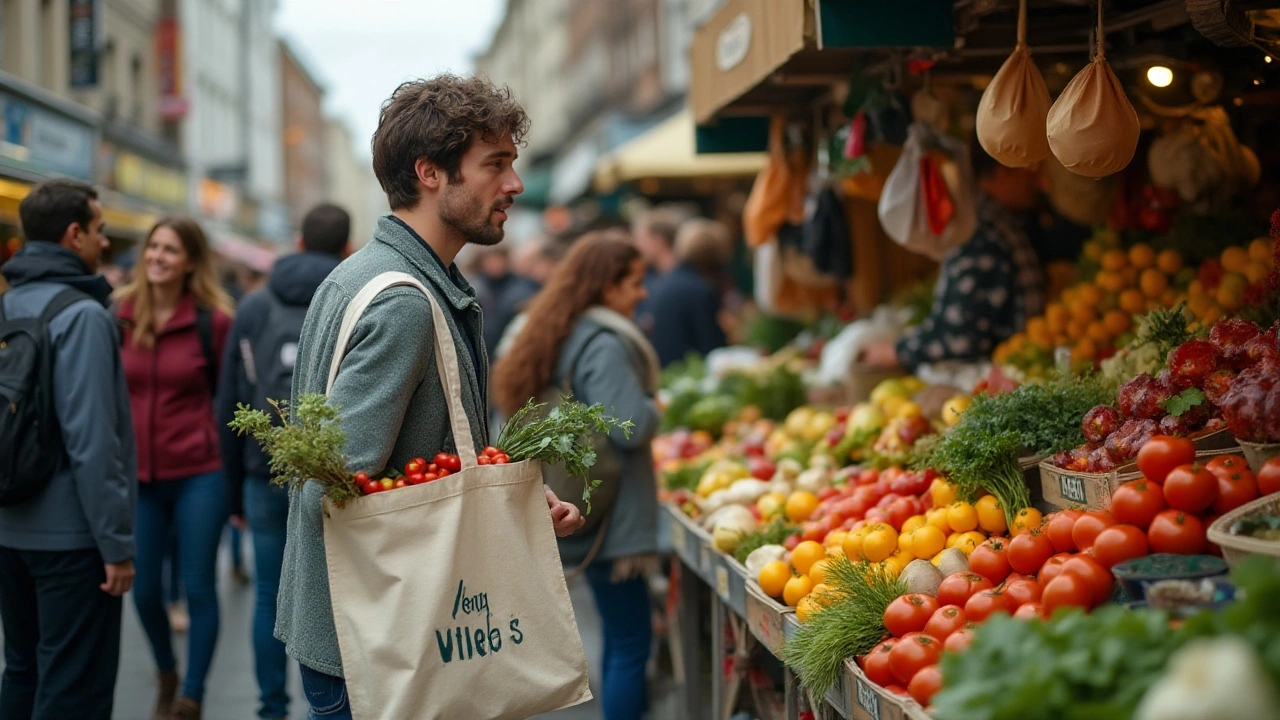Choosing a vegan lifestyle is a personal and sometimes challenging decision. Many who embark on this path do so out of a desire for a healthier life, environmental concerns, or ethical reasons. However, like any significant lifestyle change, it comes with its own set of challenges.
Finding the right nutritional balance without meat or dairy products is one such challenge. Additionally, there's the social aspect—understanding how to handle family gatherings and social events where the plant-based options might be limited or misunderstood. Then, there's the everyday task of navigating grocery stores and reading labels to ensure products align with vegan principles.
Besides practical challenges, many vegans also face cravings for familiar non-vegan foods, especially in the early days of their journey. Learning to overcome these cravings with creative, satisfying alternatives is key. This article aims to provide a roadmap through these common struggles with practical tips, nutritional advice, and mouth-watering recipes that make plant-based living both exciting and sustainable.
- Nutritional Balance
- Social Dynamics
- Eating Out Challenges
- Grocery Shopping Tips
- Overcoming Cravings
- Creative Cooking Ideas
Nutritional Balance
One of the most critical aspects of transitioning to a vegan diet is maintaining proper nutritional balance. While plant-based diets can be rich in fiber, vitamins, and low in saturated fats, they also require careful planning to ensure all essential nutrients are met. Many new vegans find themselves particularly concerned about getting adequate protein, iron, vitamin B12, calcium, and omega-3 fatty acids—all vital components for maintaining healthy body function. Protein, often the first worry for those switching to veganism, doesn't have to be problematic. Foods like lentils, chickpeas, quinoa, and tofu are excellent plant-based protein sources that can seamlessly integrate into various recipes. Enriching your meals with such ingredients ensures you get enough amino acids to support muscle maintenance and growth.
Iodine is another key mineral that vegans should be aware of since it mostly comes from fish and dairy in omnivorous diets. For plant-based diets, sea vegetables like nori and supplements can fill this gap. Iron and vitamin B12 can also present challenges, as they're predominantly found in animal products. However, incorporating lentils, seeds, and fortified foods for iron, and B12 supplements or fortified cereals can help maintain these levels. Iron absorption is enhanced by vitamin C, so combining these foods with sources like citrus fruits or bell peppers makes a big difference. In the realm of healthy fats, seeds such as flaxseeds and chia seeds, or walnuts, offer alpha-linolenic acid—an essential plant-based omega-3.
Ensuring Micronutrient Intake
Aside from macronutrients, micronutrients play a significant role in the health of any diet. While pursuing a balanced vegan lifestyle, it's crucial to monitor intake of calcium and vitamin D. Since dairy is a primary source of these nutrients in non-vegan diets, alternatives like fortified milk drinks (almond, soy, and oat) and green leafy vegetables should become a primary focus. In the words of registered dietitian Sharon Palmer,
"With the right choices and substitutions, a vegan diet can provide all the nutrients people require for a healthy life."For vitamin D, exposure to sunlight is typically encouraged, but depending on geographic location and lifestyle, supplements may be necessary.
In many discussions around vegan diets, statistics emphasize the importance of supplementing these key nutrients. Consider that research shows around 50% of people following strict vegan diets may end up deficient in vitamin B12 unless they find a reliable fortified source or take a supplement. This highlights the necessity for conscientious meal planning. To ensure a holistic and comprehensive approach to vegan nutrition, maintaining a watchful eye on one's dietary components can lead to satisfying results without compromising on health. This proactive stance not only supports long-term wellness but also aids in dispelling common misconceptions about the challenges vegans face regarding nutrition.
Social Dynamics
Embarking on a vegan journey often leads to new social dynamics, shaping conversations and relationships in unexpected ways. The decision to adopt this lifestyle sometimes places an individual in situations where their choices prompt curiosity, or in some cases, scrutiny. Family gatherings, particularly around festive occasions like Thanksgiving, can become a minefield of questions about dietary habits. This isn't just about the food—it can touch on deeper subjects like ethics, personal choices, and values.
For some, these interactions can feel daunting, almost like a constant need to explain or justify their dietary beliefs. This is why many vegans develop strategies to navigate such circumstances. A popular approach is to gently educate and invite others to try delicious plant-based dishes, transforming a potential debate into an opportunity for sharing tasty experiences. For example, serving a well-prepared cauliflower steak or a rich, creamy cashew mac and cheese can sometimes speak louder than words.
The holidays aren't the only challenge; dining out can also test one's patience. Many eating out challenges stem from limited vegan options on restaurant menus, necessitating advance research or special requests to chefs. Such situations can sometimes cause an awkwardness that the vegan may sense but their dining companions may not notice. Yet, it's encouraging to note that as plant-based diets increase in popularity, restaurants are increasingly offering creative and delightful vegan choices.
Socializing isn't just about meals, though. A vital aspect of human interaction is connection, and shared meals are fundamental to this. Therefore, vegans often find themselves as unofficial educators or ambassadors of their lifestyle. Carrying this role gracefully involves understanding when to gently inform and when to simply enjoy the moment, letting the food do the talking. A recent study published in the Journal of Ethics highlighted that people tend to respect and adopt veganism not through confrontation but through exposure to its delicious variety and ethical underpinnings.
"The power of influence often lies not in overt persuasion but in the subtle art of sharing and understanding," notes the well-respected vegan advocate and author, Isa Chandra Moskowitz.
Ultimately, a plant-based diet is more than a personal dietary choice; it becomes a chapter of one's identity. As such, navigating social waters requires a blend of confidence and empathy. It also helps to connect with supportive communities, whether online or in person, to share experiences and strategies, something that many find empowering and comforting. Resources like meetup groups and vegan potlucks can provide a sense of belonging, reinforcing that you are not alone in this journey.

Eating Out Challenges
Navigating the dining landscape when adhering to a vegan lifestyle presents its own unique set of hurdles. As restaurants and eateries strive to accommodate an increasing demand for plant-based options, many vegans still encounter difficulties finding dishes that suit their needs. The journey towards a seamless dining experience involves a mix of preparation, adaptability, and sometimes a bit of improvisation.
The first step to overcoming these vegan challenges is researching restaurant menus ahead of time. Many establishments now post their offerings online, providing a chance to identify vegan options or determine if modifications can be made. Communication is key; don't hesitate to inquire with the waitstaff about accommodating plant-based requests. Often, chefs are willing to tailor dishes to fit dietary restrictions.
While cities with a robust vegan scene offer straightforward dining experiences, smaller towns may require a bit more creativity. Here, building a rapport with local establishments can make a difference. By becoming a regular and engaging constructively with the staff, you can often inspire menu changes that benefit the broader community. Some might say patience is necessary, but conveying genuine appreciation for any accommodating efforts goes a long way.
Eating out is not just about the food but also the social experience. Some may find it challenging to navigate dinner invitations from friends or work functions where the menu doesn't cater to a plant-based diet. It's a good practice to notify the host of your dietary preferences in advance; they may appreciate the opportunity to offer an inclusive meal. Alternatively, bringing a vegan dish to share can turn a potential difficulty into a delicious conversation starter.
In an insightful observation, renowned chef Jamie Oliver has stated,
Catering to a range of dietary needs is part of the modern culinary landscape. As chefs, we owe it to our patrons to offer choices that accommodate all eating preferences, including vegans.This mindset shift underscores the importance of continued advocacy for diverse dining options in mainstream establishments.
Tablets and smartphones have made it easier to manage dining choices on the go, with apps like HappyCow offering tailored suggestions based on location. These digital resources can point you towards lesser-known gems that might surprise you with their vegan-friendly menus. The journey can be as rewarding as it is challenging, expanding your culinary horizons in unexpected ways.
The future looks bright for plant-based diners, with the restaurant industry increasingly recognizing the necessity of inclusive menus. This evolving trend brings hope and a hint of relief to the dedicated vegan. As more eateries diversify their offerings, eating out becomes a joyous occasion rather than a potential pitfall, proving that even small steps can lead to significant changes in how society embraces dietary differences.
Grocery Shopping Tips
The adventure of grocery shopping for a vegan diet can initially feel like navigating an unfamiliar landscape. Yet, with a bit of preparation and knowledge, it becomes a rewarding endeavor. As you step into the aisles, one of the first strategies is to become best friends with labels. Reading ingredient lists is crucial, as many products contain hidden animal-derived ingredients like casein, gelatin, or carmine. Recognizing these can save you from unintentional slips. An approach that proves to be quite effective is shopping the perimeter of the store, focusing on fresh produce, grains, and minimally processed foods, which naturally align with vegan principles.
Maintaining a detailed list tailored to your plant-based diet before heading out is incredibly beneficial. It aids in avoiding impulsive buys that may not fit your dietary needs and ensures you find those less obvious ingredients essential for vegan cooking like nutritional yeast, tofu, or tempeh. Another practical tip is to become familiar with different brands that cater to a vegan lifestyle. Often, new or surprising products pop up, and reading up on vegan blogs or forums can offer insights into what's worth adding to your grocery list. Engage with these communities; they're a rich resource for discovering the latest must-try vegan products.
Budgeting can often be a concern, especially if you're exploring new culinary delights. While it’s true that some pre-packaged vegan goods can be pricey, whole foods usually aren’t. Beans, lentils, rice, and seasonal fruits and vegetables are inexpensive and nutritional powerhouses. A pro-tip is to shop at local farmers' markets, not only for cost savings but also for the freshest produce. In a recent survey, it was found that households who regularly shopped at farmers' markets spent 18% less on produce compared to traditional supermarkets. Building relationships with local vendors can sometimes lead to deals and personalized tips on how best to prepare their produce.
Don't shy away from venturing into different sections, notably the bulk bins. Buying in bulk not only saves money but also minimizes packaging waste—aligning well with the sustainable aspect many vegans uphold. Look for staples like nuts, seeds, grains, and dried fruits in these sections. An array of spices can be found here too, letting you enhance your meals without breaking the bank. As a comfort, embrace the technology that's at our disposal today. Numerous apps help identify vegan products by scanning barcodes, ensuring your choices align with your diet. In this way, you develop confidence in navigating grocery stores with the ease that previously might have seemed daunting.

Overcoming Cravings
Adjusting to a plant-based diet often means confronting cravings that seem to flare up at the most inconvenient times. These cravings can feel like an insurmountable obstacle, especially when you are new to the vegan lifestyle. People transitioning to a vegan diet frequently reminisce about the taste and texture of their favorite meat or dairy meals. Fortunately, the human palate is remarkably adaptable. Cravings usually stem from emotional responses or nutritional deficiencies that can be effectively managed with some practical approaches.
First, let’s examine why these cravings occur. Taste buds can become accustomed to specific flavors and textures, and meat, dairy, and other non-vegan ingredients have a unique umami taste that can be hard to replace. According to various studies, cravings might also be linked to a lack of certain nutrients. For example, a craving for cheese might indicate a protein deficiency. It's crucial for vegans to ensure they are getting enough protein, iron, B12, and omega-3 fatty acids in their diet. Vegan recipes can remedy this by incorporating ingredients rich in these nutrients, such as beans, lentils, tofu, and seeds.
Another effective strategy is to experiment with ingredient swaps that maintain the flavor profile you crave. Innovations in vegan cooking mean that cheese-like flavors can be achieved with nutritional yeast, nuts, and seeds. These ingredients provide that creamy, tangy sensation that many miss when consuming vegan meals. When it comes to meat substitutes, products made from jackfruit or seitan can offer the savory satisfaction many yearn for. While these alternatives may not completely mimic the original, they often do the trick for quelling cravings.
Interestingly, the psychological aspect also plays a significant role in managing cravings. Some choose to adopt a 'flexible' vegan approach during their transition period. Psychologist Dr. Melanie Joy suggests practicing self-compassion, recognizing that cravings are natural and will diminish with time.
"Understand that every craving resisted is a step closer to breaking old habits," she notes, emphasizing patience in adapting to a vegan lifestyle.
Building a supportive environment is equally beneficial. Engage with online vegan communities or local meet-ups to share advice and recipes that work. You can swap tips or even experience communal cooking sessions that introduce you to new dishes that become your new comforts. Facing cravings in this supportive atmosphere can transform them into opportunities for discovering new favorites.
Finally, consider keeping a diverse and exciting menu. Regularly rotating meal plans help prevent food fatigue and keeps excitement alive in the kitchen. A varied menu filled with colors and textures not only satisfies the taste buds but also ensures that you are consuming a balanced diet, minimizing the likelihood of nutritional cravings. Remember, transitioning to a fully vegan lifestyle is a journey, and like any journey, it’s the diversity and new experiences that make it fulfilling.
Creative Cooking Ideas
When stepping into the world of veganism, one of the most delightful yet challenging tasks can be reimagining traditional dishes with a plant-based twist. Learning to think creatively in the kitchen is not just a way to maintain variety in your diet but also a rewarding adventure in itself. The key is to focus on celebrating flavors, colors, and textures that plants uniquely offer. Embrace the bounty of legumes, nuts, seeds, and whole grains that stand at the center of any plant-based diet. A simple start could be transforming a simple, classic dish into a vegan masterpiece. For instance, replacing ground meat in a taco with spiced lentils or sautéed mushrooms can surprise and delight the palate.
One inspiring approach is to dive into global cuisines that naturally highlight vegan ingredients. Indian and Middle Eastern dishes, for example, often integrate lentils, chickpeas, and rich spices to create hearty, flavorful meals that require little adaptation. Trying your hand at making a creamy, coconut-based Thai curry or a robust Moroccan tagine opens up a world of flavors without the need for animal products. As you explore, you'll find that many cultures have been embracing plant-based eating long before it became a global trend. Remember, the journey of cooking is all about discovering what resonates with your taste and nutritional needs.
Incorporating more plants doesn't mean you have to abandon the essence of hearty comfort foods. Cheese lovers, for example, might think about crafting a vegan version of mac and cheese using a rich cashew-based sauce, nutritional yeast for that cheesy flavor, and a dash of turmeric for color. You'll be amazed at how satisfying this dairy-free alternative can be. The same principle can be applied to creating creamy soups or sauces where nuts and seeds, like almonds or sunflower seeds, take center stage and offer a smooth, indulgent texture.
For those with a sweet tooth, exploring vegan baking is another arena where creativity knows no bounds. From using ripe bananas or applesauce in place of eggs to experimenting with plant-based butters or oils, the options are endless. Fine-tuning your skills with aquafaba—the magical liquid from canned chickpeas—is an excellent idea for making airy, egg-free meringues and pavlovas. And you may just discover that with the wealth of alternatives available, such as almond milk ice cream or coconut whipped cream, you won’t even miss their dairy counterparts.
The experimentation doesn’t end with cooking alone—presentation and taste pairing can bring a whole new dimension to your vegan creations. Arranging, and combining textures and flavors, can greatly enhance the eating experience. Adding a sprinkle of crunchy seeds or nuts, or a drizzle of balsamic glaze, can bring that extra ‘wow’ factor that makes a meal memorable. Creating unforgettable plant-based dishes is not about imitating meat but rather celebrating the endless potential of vegetables and grains in their own right. As the renowned chef Angela Liddon wisely notes,
“Plant-based cooking is not about deprivation, it’s about abundance.”Embrace the opportunity to explore and ignite your creativity with vibrant, nourishing foods that not only sustain your body but also thrill your culinary spirit.

